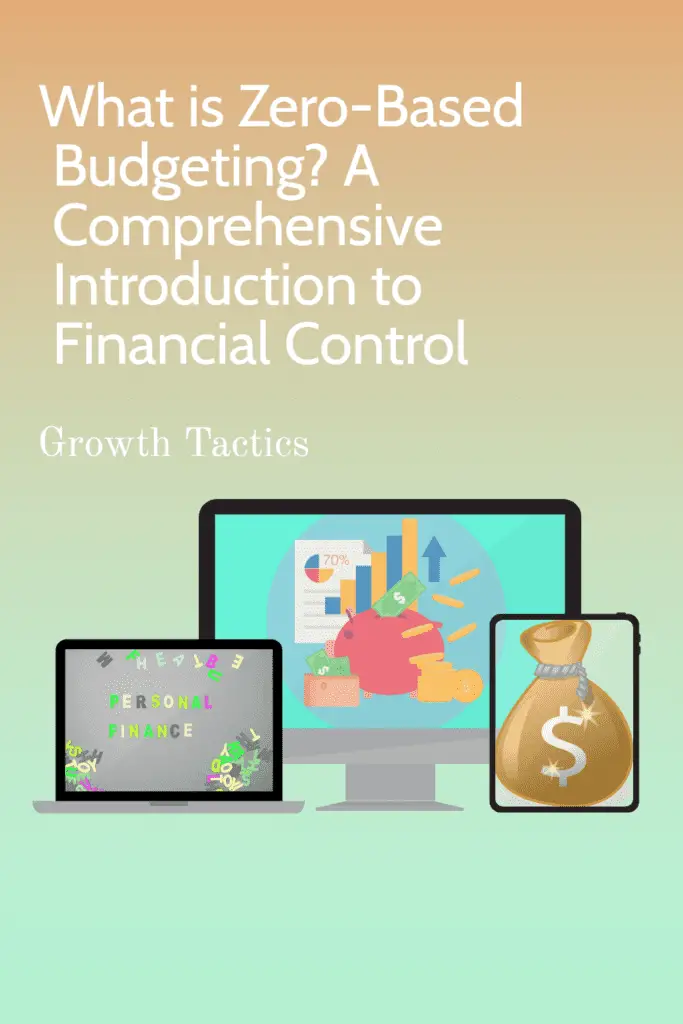Are you looking for a way to take control of your finances and make smarter decisions with your money? Look no further! In this comprehensive introduction, we’ll dive into the world of zero-based budgeting, a powerful financial control method that can transform your approach to budgeting.
By starting from scratch and justifying every expense, zero-based budgeting ensures that every dollar is allocated purposefully and effectively. Join us as we explore the ins and outs of this innovative method, from its many benefits to best practices for creating your own zero-based budget. Let’s embark on a journey toward greater financial discipline and success!
Jump To Section
What is Zero-Based Budgeting?
Zero-based budgeting (ZBB) is a financial control tool that allows you to manage your money more effectively. It’s an alternative to traditional budgeting and can be used by businesses of any size, but it’s particularly useful for those who have never done it before or need help refining their current process.
Zero-based budgeting works by starting from scratch each year with every aspect of your business–including revenue and expenses–and then building out from there. This approach allows you to analyze your finances more closely than ever before, which will help bring clarity into how much money comes in versus how much goes out.
How to Make a Zero-Based Budget

To make a zero-based budget, you’ll need to gather the necessary information. This can be done by reviewing past budgets or analyzing your current spending habits. You should also consider how much money you have available for expenses and if there are any unexpected costs that may arise during the month.
The steps for making a zero-based budget are as follows:
- Set your financial goals and objectives: Before you can start creating a budget, it’s important to identify your financial goals and objectives. This will help you prioritize your spending and make sure you’re allocating your resources in a way that aligns with your long-term vision.
- Determine your income: Calculate your total income, including all sources of revenue such as salaries, bonuses, and interest income. This will give you a clear picture of how much money you have available to allocate towards your expenses.
- Identify your expenses: List out all your expenses, including fixed expenses (such as rent or mortgage payments) and variable expenses (such as groceries, gas, and entertainment). Be sure to categorize your expenses so you can see where your money is going.
- Prioritize your expenses: Once you’ve identified your expenses, prioritize them based on their importance. This will help you make tough decisions when you need to cut back on spending or allocate more resources to a particular area.
- Allocate your income to your expenses: Beginning with your highest priority expenses, allocate your income to each expense category until you’ve accounted for every dollar. This means that your income minus your expenses should equal zero.
- Monitor and adjust: Once you’ve created your zero-based budget, it’s important to monitor your spending to make sure you’re staying on track. Adjust your budget as needed to reflect changes in your income or expenses, and be sure to revisit your financial goals and objectives periodically to make sure they’re still relevant.
By following these steps, you can create a zero-based budget that helps you take control of your finances and achieve your long-term financial goals.
Advantages and Disadvantages of Zero-Based Budgeting

Advantages of Zero-Based Budgeting:
- Increases accountability: One of the biggest advantages of zero-based budgeting is that it increases accountability. This is because every expense must be justified each year, which means that departments and teams are more likely to carefully consider their spending and prioritize their expenses.
- Eliminates wasteful spending: Zero-based budgeting forces organizations to scrutinize every expenditure and make sure that it’s necessary and productive. This can lead to the elimination of wasteful spending and inefficiencies, resulting in significant cost savings.
- Provides a fresh start: By starting from scratch and justifying every expense, zero-based budgeting provides a fresh start each year. This can help organizations break free from the status quo and identify new opportunities for growth and innovation.
- Encourages collaboration: Zero-based budgeting requires input from all levels of the organization, which can foster collaboration and communication. This can lead to better decision-making and a more cohesive team.
Disadvantages of Zero-Based Budgeting:
- Time-consuming: Zero-based budgeting can be a time-consuming process, as every expense must be justified each year. This can take a significant amount of time and resources away from other important tasks.
- Lack of flexibility: Zero-based budgeting is focused on the current year, which means that it can be difficult to plan for future events or unexpected changes. This lack of flexibility can make it challenging to adjust the budget mid-year if circumstances change.
- Requires a high level of detail: Zero-based budgeting requires a high level of detail and accuracy in order to be effective. This can be challenging for organizations that don’t have the necessary resources or expertise to create a comprehensive budget.
- Can be disruptive: Implementing zero-based budgeting can be disruptive to the organization, as it requires a significant shift in mindset and culture. This can be difficult for some employees and may lead to resistance or pushback.
In conclusion, while zero-based budgeting has its advantages and disadvantages, it can be a powerful tool for organizations looking to increase accountability, eliminate wasteful spending, and foster collaboration. However, it’s important to carefully consider the resources needed to implement this method and to weigh the potential benefits against the potential drawbacks before making a decision.
Zero-Based Budgeting vs. Traditional Budgeting
Zero-Based Budgeting (ZBB) and Traditional Budgeting are two different approaches to personal financial management. Both methods have their advantages and disadvantages, and understanding the differences can help individuals choose the best approach for their financial situation.
Traditional Budgeting is a simpler method, often focused on tracking and categorizing expenses based on past spending habits. This approach helps individuals identify areas where they may be overspending and adjust their budgets accordingly. However, traditional budgeting can also make it difficult to adapt to changing financial needs and goals, as it relies heavily on historical data.
Zero-Based Budgeting, on the other hand, is a more proactive and detailed approach to personal finance. With ZBB, individuals start with a clean slate and allocate their income to various expense categories based on their current needs and priorities. This process ensures that every dollar is accounted for and assigned a purpose, ultimately helping individuals achieve their financial goals more effectively.
The main advantage of Zero-Based Budgeting over Traditional Budgeting is its flexibility and adaptability. By starting from scratch and evaluating every expense based on current needs, individuals can more easily make adjustments to their budgets as their financial situation changes. This can be especially beneficial for those who experience fluctuations in income or who have significant life changes that impact their finances.
However, it’s important to note that Zero-Based Budgeting can be more time-consuming and requires a higher level of detail and organization compared to Traditional Budgeting. Individuals who choose to implement ZBB should be prepared to invest time and effort in creating and maintaining their budget.
Zero-Based Budgeting Examples

Zero-based budgeting is a financial control method that can be used by companies and individuals alike. It’s an effective way to analyze your spending habits, identify areas where you could save money, and make better decisions about how you spend money in the future.
Here are some examples of companies using zero-based budgeting:
- Apple Inc., one of the most successful technology companies in history, uses zero-based budgeting as part of its financial control process. Apple employees must justify every dollar they spend on new equipment or services before any purchases are made. This ensures that no unnecessary purchases will be made without careful consideration from upper management first–and helps keep costs down for everyone involved!
Tips for Making a Zero-Based Budget
Here are some tips for making a zero-based budget:
Use the previous period’s actuals as a baseline. This will help you get an accurate picture of where your company stands financially so that you can plan accordingly for the future.
Allocate funds for needs and wants. You should use this step to determine how much money each department or team needs in order to function properly, as well as how much money is left over for discretionary spending, or “wants.” This can include items such as employee training, technology upgrades, or team-building activities. It’s important to strike a balance between meeting essential needs and investing in growth opportunities.
Be realistic with your estimates. When making a zero-based budget, it’s crucial to be as accurate as possible with your projections. Avoid overestimating revenue or underestimating expenses, as this can lead to financial strain and the need for budget adjustments later on.
Involve stakeholders in the budgeting process. Engaging team members, department heads, and other stakeholders in the budgeting process can provide valuable input and help identify cost-saving measures or areas for improvement. This collaborative approach can lead to better financial decision-making and increased buy-in from those who will be affected by the budget.
Continuously monitor and adjust the budget. A zero-based budget is not a one-time exercise. It requires ongoing attention and review to ensure that actual spending aligns with the budget and to make adjustments as needed. Regularly examine your financial performance and adjust your budget to reflect any changes in your business environment, goals, or priorities.
Prioritize and rank spending categories. By ranking spending categories based on their importance to your business, you can allocate funds more effectively and ensure that high-priority areas receive adequate attention. This will also help you make tough decisions when it comes to cutting costs, as you’ll have a clear understanding of which areas are most critical to your organization’s success.
Don’t forget to budget for emergencies and contingencies. Unexpected expenses or changes in circumstances can arise at any time, so it’s important to set aside funds for emergencies and contingencies within your zero-based budget. Having a financial cushion can help you navigate challenges without derailing your budget or jeopardizing your financial stability.
Embrace technology. Utilize budgeting software and tools to streamline the zero-based budgeting process, improve accuracy, and enable real-time tracking of expenses. These tools can also facilitate collaboration and communication among team members, making the budgeting process more efficient and effective.
By following these tips, you’ll be better equipped to create a zero-based budget that helps your organization achieve its financial goals while maintaining control over expenses and prioritizing investments that drive growth and success.
Did you enjoy this article on what a zero-balance budget is? Please share and subscribe below.


